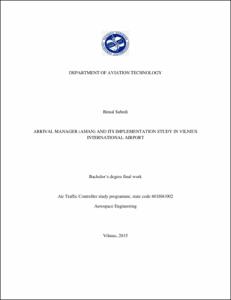Arrival manager (AMAN) and its implementation study at Vilnius International Airport

Visualitza/Obre
Estadístiques de LA Referencia / Recolecta
Inclou dades d'ús des de 2022
Cita com:
hdl:2117/86339
Realitzat a/ambVilniaus Gedimino technikos universitetas
Tipus de documentTreball Final de Grau
Data2015-03-10
Condicions d'accésAccés obert
Tots els drets reservats. Aquesta obra està protegida pels drets de propietat intel·lectual i
industrial corresponents. Sense perjudici de les exempcions legals existents, queda prohibida la seva
reproducció, distribució, comunicació pública o transformació sense l'autorització del titular dels drets
Abstract
The aim of this thesis is to study in detail the working principle of AMAN, its components involved, develop a trajectory prediction simulator using BADA 3.6 and compare the initial flight plan predicted time with that of TP simulator. Due to the increasing traffic demands in major European airports, those airports are implementing it to assist the controllers and decrease their workload. AMAN is used to balance the flow of inbound aircraft and capacity of airport by proving sequence of aircrafts approaching the runway and it also helps controllers in the sequencing and merging process which reduces the workload of the controllers. In this thesis special attention is given to Baltic FAB and in particular study of AMAN and its implementation is done for Vilnius International Airport. The objective of thesis is to develop a trajectory prediction simulator because all AMAN's are based on prediction of aircrafts arrival time and is also the most important part of the AMAN. In order to develop this simulator software like MATLAB and NEST are used. However all the aircraft performance data for descent phase of aircrafts are obtained using the BADA 3.6. The arrival time calculated by the trajectory prediction simulator is quite similar to that of initial flight plan arrival time. Better result in the prediction of arrival time is obtained using the trajectory prediction simulator. Nevertheless, we need to take into account that some assumptions were made in the development of the simulator and the results obtained are not hundred percent realistic. On the other hand, it is seen that the traffic growth is getting higher and higher every year in Vilnius International Airport. But, it is operating far below the potential physical capacity of the airport and provided with higher number of flights to and from this airport, it can handle the traffic without any major problems. In long run if the air traffic goes on increasing in the same rate then there will be the need of AMAN implementation in Vilnius Airport to assist controllers and maintain the security level marked by the SESARJU.
TitulacióGRAU EN ENGINYERIA D'AERONAVEGACIÓ (Pla 2010)
| Fitxers | Descripció | Mida | Format | Visualitza |
|---|---|---|---|---|
| memoria.pdf | 2,681Mb | Visualitza/Obre |

